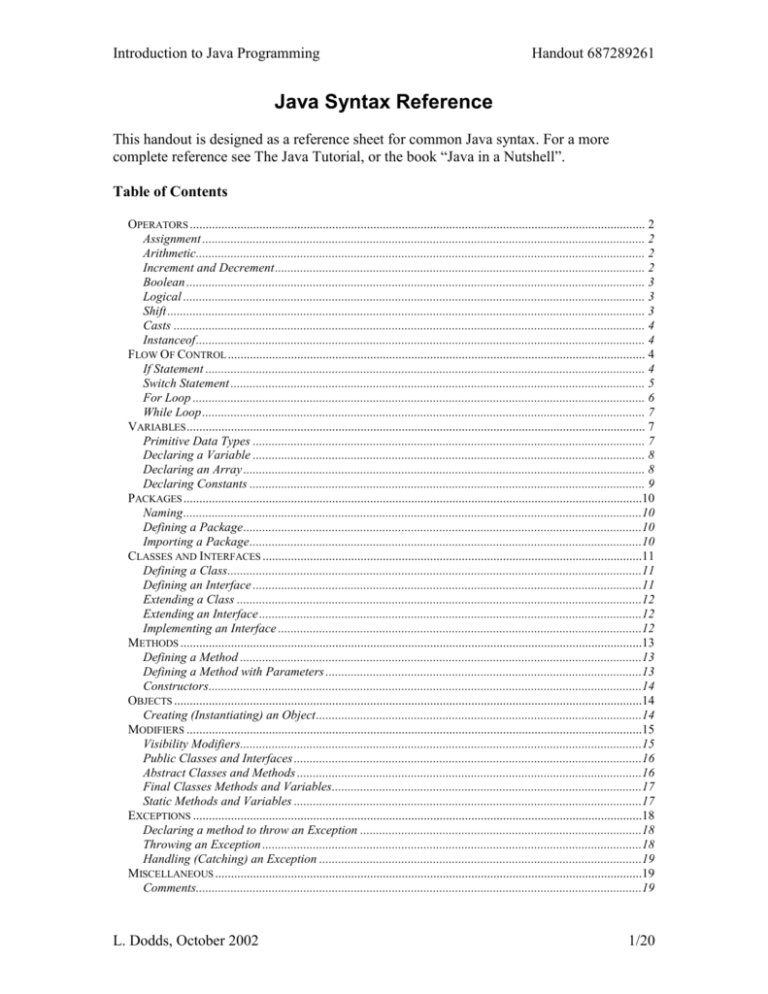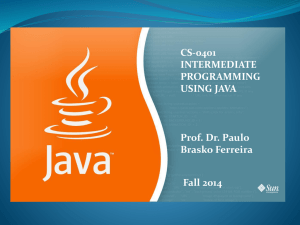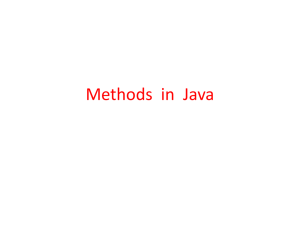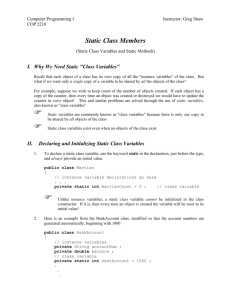Java Syntax Reference
advertisement

Introduction to Java Programming
Handout 687289261
Java Syntax Reference
This handout is designed as a reference sheet for common Java syntax. For a more
complete reference see The Java Tutorial, or the book “Java in a Nutshell”.
Table of Contents
OPERATORS ................................................................................................................................................ 2
Assignment ............................................................................................................................................ 2
Arithmetic.............................................................................................................................................. 2
Increment and Decrement ..................................................................................................................... 2
Boolean ................................................................................................................................................. 3
Logical .................................................................................................................................................. 3
Shift ....................................................................................................................................................... 3
Casts ..................................................................................................................................................... 4
Instanceof .............................................................................................................................................. 4
FLOW OF CONTROL .................................................................................................................................... 4
If Statement ........................................................................................................................................... 4
Switch Statement ................................................................................................................................... 5
For Loop ............................................................................................................................................... 6
While Loop ............................................................................................................................................ 7
VARIABLES ................................................................................................................................................. 7
Primitive Data Types ............................................................................................................................ 7
Declaring a Variable ............................................................................................................................ 8
Declaring an Array ............................................................................................................................... 8
Declaring Constants ............................................................................................................................. 9
PACKAGES .................................................................................................................................................10
Naming .................................................................................................................................................10
Defining a Package ..............................................................................................................................10
Importing a Package ............................................................................................................................10
CLASSES AND INTERFACES ........................................................................................................................11
Defining a Class...................................................................................................................................11
Defining an Interface ...........................................................................................................................11
Extending a Class ................................................................................................................................12
Extending an Interface .........................................................................................................................12
Implementing an Interface ...................................................................................................................12
METHODS ..................................................................................................................................................13
Defining a Method ...............................................................................................................................13
Defining a Method with Parameters ....................................................................................................13
Constructors.........................................................................................................................................14
OBJECTS ....................................................................................................................................................14
Creating (Instantiating) an Object .......................................................................................................14
MODIFIERS ................................................................................................................................................15
Visibility Modifiers...............................................................................................................................15
Public Classes and Interfaces ..............................................................................................................16
Abstract Classes and Methods .............................................................................................................16
Final Classes Methods and Variables..................................................................................................17
Static Methods and Variables ..............................................................................................................17
EXCEPTIONS ..............................................................................................................................................18
Declaring a method to throw an Exception .........................................................................................18
Throwing an Exception ........................................................................................................................18
Handling (Catching) an Exception ......................................................................................................19
MISCELLANEOUS .......................................................................................................................................19
Comments.............................................................................................................................................19
L. Dodds, October 2002
1/20
Introduction to Java Programming
Handout 687289261
Keywords .............................................................................................................................................20
Legal Names ........................................................................................................................................20
Operators
Assignment
<variable name> = <expression>;
Example:
int myNumber;
myNumber = 1;
<expression> is a variable, function, or parameter -- or any combination of
them, with operators and parentheses -- that evaluates to the same type as
<variable name>.
If <variable name> has been declared final, then <variable name> can
only be assigned a value when it is declared. All subsequent attempts to assign a
value to <variable name> are compile time errors.
Arithmetic
+
/
*
%
Addition
Subtraction
Division, ignoring remainder
Multiplication
Modulo, remainder of dividing x by y
Increment and Decrement
Operator Description
++
Adds one to the variable and
stores and stores the new
value in that variable
-Removes one from the
variable and stores the new
value in that variable
+=
Adds the specified number to
the variable and stores the
new value in that variable
-Removes the specified
number to the variable and
stores the new value in that
variable
L. Dodds, October 2002
Example
x++
y--
x += 5
y -= 5
2/20
Introduction to Java Programming
*=
Handout 687289261
Multiplies the variable by the
specified number and stores
the new value in that variable
Divides the variable by the
specified number and stores
the integer result in that
variable
/=
x *= 2
y /= 2
Boolean
!=
>
<
>=
<=
==
not equal to
greater than
less than
greater than or equal to
less than or equal to
equal to
Note that when testing equality of objects, use the equals method. E.g.
object1.equals(object2). This will test whether the objects are equal in
terms of their attributes, whereas using == will only test whether the two
variables are actually references to the same object.
Logical
Operator
&&
||
!
&
Description
Example
logical AND
A && B
logical OR
A || B
logical NOT (logical negation)
!A
boolean logical AND
true & true
(both operands must be booleans)
^
boolean logical exclusive OR
false ^ false
(both operands must be booleans)
|
boolean logical inclusive OR
true | false
(both operands must be booleans)
Note that similarly to the assignment operators, there are short forms available for
working with the logical operators. E.g. x |= y perform a logical OR of x and y
and then assigns this new value to x.
Shift
Operator
>>
<<
>>>
Use
op1 >> op2
op1 << op2
op1 >>> op2
L. Dodds, October 2002
Operation
shift bits of op1 right by distance op2
shift bits of op1 left by distance op2
shift bits of op1 right by distance op2 (unsigned)
3/20
Introduction to Java Programming
Handout 687289261
Casts
<variable name 1> = (<new type>)<variable name 2>;
Example:
float myFloat;
int myInt;
myFloat = (int)myInt;
Casting does not change an object, just the type used to reference it.
Casting from one primitive type to another may cause some loss of precision.
When casting an object, if the cast is not legal then a ClassCastException
is thrown.
Instanceof
The instanceof operator checks whether one object is an instance of another,
<variable> instanceof <classname>
Example:
myString instanceof String
An object is an instance of a class if it directly or indirectly descends from that
class.
Flow Of Control
If Statement
if( <condition> ) {
<statementsToDoIfConditionTrue>
}
If-Else:
if( <condition> ) {
<statementsToDoIfConditionTrue>
} else {
<statementsToDoIfConditionFalse>
}
If-Else-If:
L. Dodds, October 2002
4/20
Introduction to Java Programming
Handout 687289261
if( <condition> ) {
<statementsToDoIfConditionTrue>
} else if( <otherCondition> ) {
<statementsToDoIfOtherConditionTrue>
} else {
<statementsToDoIfNoneAreTrue>
}
Examples:
if (x && y) {
/* code if true */
}
if (shoppingCart.isEmpty())
{
/* code is shopping cart empty
}
else
{
/* code if shopping cart is not empty
}
Switch Statement
switch <selector> {
case <value 1> :
<statement 1>;
break;
case <value 2> :
<statement 2>;
break;
case <value n> :
<statement n>;
break;
default :
<statement n+1>
break;
}
Example:
L. Dodds, October 2002
5/20
Introduction to Java Programming
Handout 687289261
switch (shoppingCart.size())
{
case 1:
{
showMessage(“You have one item in your shopping cart”);
break;
}
case 2:
{
showMessage(“You have two items in your shopping cart”);
break;
}
default:
{
showMessage(“You have no items in your shopping cart”);
}
}
The break statement causes the program to proceed with the first statement after
the switch structure. The break statement is used because otherwise the
cases of the switch statement would otherwise run together. If break is not
used anywhere in a switch structure, then each time a match occurs in the
structure, the statements for all the remaining cases will be executed (or until a
break is encountered).
The <selector> for a select statement must be an integer, char, or an
enumerated type.
If the <selector> does not match any of the values, then the default statement
is executed.
For Loop
for (<counter initialization>; <loop continuation condition>; <counter
increment>) {
/* Java statements */
}
Example:
//count from one to ten
for (int i=1; i<10; i++) {
System.out.println(i);
}
<counter initialization> is a variable of an ordinal type, such as an
integer initialized to a value.
The <loop continuation condition> determines how long the
program will continue to loop.
<counter increment> increments the counter using an increment
operator, usually <counter>++.
L. Dodds, October 2002
6/20
Introduction to Java Programming
Handout 687289261
When the for structure begins executing, the counter is initialized. Then, the
<loop continuation condition> is checked. If the condition is
satisfied, then the statements in the loop body are executed. Finally the
counter is incremented. The loop begins again by checking the <loop
continuation condition>. This process continues until the control
variable no longer satisfies the <loop continuation condition>.
The program then continues by performing the first statement after the loop.
A break statement inside a for loop causes the loop to end
A continue statement inside a for loop skips the remaining statements in
the body of that structure, and proceeds with the next iteration of the loop
While Loop
while (<continuation condition>) {
/* Java statements */
}
Example:
int num = 0;
while (num < 10) {
/* Java statements */
num++;
}
<continuation condition> is a variable or expression that evaluates to a
boolean.
<continuation condition> is tested before the body of the loop is
executed. If <continuation condition> is true, the body is executed.
When the loop body has been executed, the <continuation condition> is
checked again. The loop continues to execute until the <continuation
conditon> is false.
A break statement inside a while loop causes the loop to end
A continue statement inside a while loop skips the remaining statements in the
body of that structure, and proceeds with the next iteration of the loop
Variables
Primitive Data Types
There are eight primitive data types in Java
Type
Boolean
Description
A Boolean value (true or false)
Byte
Short
Int
Byte-length integer
Short integer
Integer
Size
1 bit. true or
false
L. Dodds, October 2002
1 byte
2 bytes
4 bytes
7/20
Introduction to Java Programming
Long
Float
Double
Char
Long Integer
Single precision floating point
number
Double precision floating point
number
A single character
Handout 687289261
8 bytes
4 bytes
8 bytes
2 bytes.
Unicode
character
As well as primitive types, Java has the notion of reference types. Arrays,
classes and interfaces are all reference types. I.e. they refer to an object in
memory rather than a primitive value. A reference type is equivalent to a pointer
in C, but the objects are referenced by name rather than memory location.
Declaring a Variable
<modifiers> <datatype> <variable name>;
…or, to initialize the variable when it’s declared:
<modifiers> <datatype> <variable name> = <expression>;
An instance variable describes the state of an instance. It is declared within
the scope of a class. If an instance variable is given an initial value, that value is
stored in the variable before the first statement of the constructor of the object is
executed.
A local variable is a temporary storage place of information. It is declared
within the scope of an individual method.
<modifiers> is an optional space-separated list of valid modifiers. Only
instance variables can have a list of modifiers (e.g. private final). See Modifiers.
<datatype>, either the name of a class or a primitive type, declares to which
type of class the variable will refer to, or which primitive type the variable will
be.
<variable name> is any valid identifier which is unique to the current scope.
<expression> is an optional variable, function, or parameter - or any
combination of them, with operators and parentheses - that evaluates to the same
type as <datatype> and whose value the variable should assume immediately
upon creation.
Declaring an Array
<modifiers> <data type>[] <array name>;
<array name> = new <data type>[<array size>];
or, to allocate the size of the array when its declared:
<modifiers> <data type>[] <array name> = new <data type>[<array size>];
L. Dodds, October 2002
8/20
Introduction to Java Programming
Handout 687289261
or, to initialize the array when its declared:
<modifiers> <data type>[] <array name> = {<comma separated list of
values>};
Examples:
private int[] myArray; // declares the array
myArray = new int[20]; // allocates the array to hold 20 ints
private int[] myArray = new int[20];
// creates a five element array of integers and initializes
// the elements to 1, 2, 3, 4, 5
private int[] myArray = {1, 2, 3, 4, 5};
Arrays are zero-based.
<modifiers> is an optional space-separated list of valid modifiers. See
Modifiers.
<data type>, either the name of a class or a primitive type, declares to what
type the array will hold references.
<variable name> is any valid identifier which is unique to the current scope.
<array size> is an integer that allocates the size of the array (how many
references it can hold).
<comma-separated list of values> are items of the declared data
type. This list initializes the size of the array to the number of values, and
initializes the elements of the array to those values.
Arrays have a length property which hold their size, e.g. myArray.length
Rather than writing your own code to copy one array into another use the
System.arraycopy() method.
Declaring Constants
A class constant:
<visibility modifier> static final <datatype> <constant name> =
<constant value>;
A constant variable inside an object or method:
final <datatype> <constant name> = <constant value>;
Use class constants for ‘global variables’ that must be shared by all instances of a
class.
Use constant variables inside an object to ensure that the variable is only ever
assigned a single value.
L. Dodds, October 2002
9/20
Introduction to Java Programming
Handout 687289261
Packages
Naming
A package is a group of Java classes. All classes within a package must have a unique
name. The standard convention is to name packages using a “reverse domain name”
format. For example if I own the domain name mydomain.com then I would give my
packages names like
com.mydomain.package1
com.mydomain.package2
This convention has arisen to avoid naming clashes in code created by different
companies.
Of course if you don’t own a domain name then you’re free to name your packages as
appropriate. Using the application name as a prefix is a good option. As a rule you should
always place your code in a package.
Note: when your code is compiled in Java classes, the Java compiler will organise the
classes into directories according to the package names. E.g. all classes in the
com.mydomain.package1 package will be compiled into the
com/mydomain/package1/ directory.
Defining a Package
package <package name>;
The package statement must appear before any other Java statements in the file, or be
omitted entirely. If the package statement is omitted, then a file is assumed to be in the
default package, to which all package-less classes belong.
All files in the same package must use the same <package name>.
Importing a Package
Classes in a package must be referenced by their fully qualified class name (e.g.
com.mydomain.package1.MyClass) unless that package is imported.
import <package name>.<class name>;
import <package name>.<interface name>;
import <package name>.*;
<package name> is a valid package identifier which is not the current
package.
<class name> is any public class defined in <package name>.
<interface name> is any public interface defined in <package name>.
L. Dodds, October 2002
10/20
Introduction to Java Programming
Handout 687289261
An import that uses only a class or interface name only imports that single class.
Using an asterisk will cause all classes in that package to be imported.
Java always imports java.lang.* for every file at compile-time.
Classes and Interfaces
Defining a Class
<modifiers> class <class name> {
/* Instance variables declared and methods defined here */
}
Example:
public class myClass {
/* instance variables */
/* constructors */
/* methods */
}
For definition of <modifiers> see Modifiers.
A class definition normally contains one or more constructors. If a constructor is
not defined, the Java compiler will supply a default constructor automatically.
Defining an Interface
<modifiers> interface <interface name> {
/* Abstract methods and class constants declared here */
}
Example:
public interface myInterface {
int MY_CONSTANT = 10;
void myMethod();
}
For definition of <modifiers> see Visibility Modifiers.
A method declared in an interface cannot have a default implementation, nor can
it be declared private, protected, static, final, or
synchronized.
An instance variable declared in an interface is considered a class constant. It
cannot be declared private, protected, or synchronized.
All methods declared in an interface are implicitly abstract and public.
All instance variables declared in an interface are implicitly public,
static, and final, and therefore must include an initial value in the
declaration.
L. Dodds, October 2002
11/20
Introduction to Java Programming
Handout 687289261
Extending a Class
<modifiers> class <class name> extends <superclass name> {
}
Example:
public class MotorVehicle extends Vehicle {
}
<class name> will inherit all non-private methods and instance variables
defined in <superclass name>. Thus the methods and instance variables
defined for <class name> need be only those things needed to specialize the
class.
A class that implements interfaces can also inherit from a superclass. The
superclass must be extended before the interfaces are implemented:
public class myClass extends superClass implements myInterface {
}
Extending an Interface
<modifiers> interface <interface name> extends <superinterface list> {
/* Class constants and abstract methods declared here */
}
Example:
public interface myInterface extends superInterface {
/* Class constants and abstract methods declared here */
}
<superinterface list> is a comma-separated list of interfaces from
which this interface should inherit.
<interface name> will inherit all the method declarations and class
constants in each of the interfaces listed in <superinterface list>. Thus
the methods and class constants defined for <interface name> need be only
those things needed to specialize the interface.
Implementing an Interface
<modifiers> class <class name> implements <interface list> {
/* Instance variables declared and methods defined here */
}
Example:
L. Dodds, October 2002
12/20
Introduction to Java Programming
Handout 687289261
public class myClass implements myInterface {
/* Instance variables declared and methods defined here */
}
<interface list> is a comma-separated list of interfaces which the class
should implement. It is expected that a class which implements an interface will
provide a definition for every method declared in that interface. If it does not, then
the class must be declared abstract.
<class name> has direct access to all class constants defined in the interfaces
it implements.
Methods
Defining a Method
<modifiers> <return types> <method name>() {
/* statements */
}
Example:
private void myMethod() {
/* statements */
}
<modifiers>. See Modifiers.
<return type> is either void (meaning that this method does not return a
value), a name of a class, or a base type.
<method name> is any valid identifier which is unique to the class. It names a
block of statements which, when executed in order, define a behavior for the
class.
Defining a Method with Parameters
<modifiers> <return type> <method name>(<parameter list>) {
/* statements */
}
Where <parameter list> is structured as follows:
<parameter type1> <parameter name1>,
<parameter type2> <parameter name2>,
<parameter typeN> <parameter nameN>
Example:
public void drawCircle(int radius, Color colour) {
/* statements */
}
L. Dodds, October 2002
13/20
Introduction to Java Programming
Handout 687289261
A method can be overloaded. This means that multiple methods with the same
name but different parameter lists can be declared within the same class. The
JVM will determine the correct method to run by examining the parameters
passed used in the method call. Methods cannot be overloaded to have different
return types.
Constructors
<modifiers> <class name>(<parameter list>) {
/* statements to initialize the object */
}
Example:
public class myClass {
/* Instance variables declared */
public myClass() { // the Constructor
/* statements to initialize objects of myClass */
}
}
A constructor is a method with the same name as the class.
The constructor is invoked automatically each time an object of that class is
instantiated.
Constructors may be overloaded to provide a variety of means for initializing an
object.
Constructors cannot specify return types or return values.
Objects
Creating (Instantiating) an Object
<variable name> = new <class name>();
Example:
Shape circle;
circle = new Shape();
<variable name> is a variable or parameter of the same type as <class
name>.
When executed, Java will create a new instance of <class name> and call the
appropriate constructor for the <class name> on the new instance. A reference
to the new object is stored in <variable name>.
L. Dodds, October 2002
14/20
Introduction to Java Programming
Handout 687289261
Modifiers
There are various modifiers that can be applied when declaring classes, interfaces,
methods and variables. These are reviewed in the following sections. In some cases
modifiers have subtly different meaning depending on the type of structure (e.g. class or
method) to which they’re being applied.
Visibility Modifiers
Visibility modifiers control the encapsulation of a class, its attributes and behaviours
Public
A method which is declared public is
visible to every object, including those
outside of the package in which the class
which contains the method is defined.
Likewise, an instance variable declared
public can be accessed and modified by
any object. You should never do
this, as it breaks
encapsulation.
Protected
Subclasses inherit public methods and
instance variables and have full access to
them.
A protected method is accessible by any
object in the same package, or by any
subclass, regardless of package.
A protected instance variable can also be
accessed and modified by any object in the
same package.
Private
None
Subclasses inherit protected instance
variables and have full control over them.
A private method or instance variable is
visible only to the object in which it is
defined or declared.
Subclasses do not inherit private methods
or instance variables.
Default, or “package scope”.
The method or variable is only visible to
objects in the same package.
L. Dodds, October 2002
15/20
Introduction to Java Programming
Handout 687289261
Public Classes and Interfaces
Declare the class or interface as public to ensure that it can be accessed from outside its
package. This is the most common way of declaring Java classes.
public <other modifiers> class <class name> {
/* Instance variables declared and methods defined here */
}
public interface <interface name> {
/* Interface definition here */
}
Example:
public class Circle {
/* Instance variables declared and methods defined here */
}
By defining a class as public, a class in another package can instantiate that
class, inherit from it, maintain a reference to an instance of it, or access its static
methods and instance variables (if any).
By defining an interface as public, an interface in another class can inherit from
it or have a reference to an instance of it as a parameter, and a class in another
package can implement it, maintain a reference to an instance of an
implementation of it, or access it class constants.
Abstract Classes and Methods
Abstract method:
abstract <other modifiers> <return type> <method name>();
Abstract class:
abstract <other modifiers> class <class name> {
/* Instance variables declared and methods defined here. */
}
Examples:
abstract public void animate();
abstract public class Shape {
/* Instance variables declared and methods defined here. */
}
A method which is declared abstract is not followed by a definition; instead, the
declaration line simply ends in a semicolon. This indicates that a subclass must
provide an implementation of this method, otherwise it cannot be instantiated.
L. Dodds, October 2002
16/20
Introduction to Java Programming
Handout 687289261
A class which is declared abstract cannot be instantiated. It is available for subclassing only. An abstract class often has one or more abstract methods.
A class or method cannot be declared as both abstract and final.
A variable cannot be declared abstract.
Final Classes Methods and Variables
Final variable:
final <other modifiers> <data type> <constant name> = <constant value>;
Final method:
final <other modifiers> <return type> <method name>(<parameter list>) {
/* Java statements */
}
Final class:
final <other modifiers> class <class name> {
/* Instance variables declared and methods defined */
}
Examples:
final int constantNum = 1;
final void myMethod() {
/* Java statements */
}
final class myClass {
/* Instance variables declared and methods defined here */
}
The final modifier can be used with variables to create constants. A value must
be assigned to the variable at declaration, and then cannot be changed. See also
Declaring Constants
A final method cannot be redefined in a subclass.
A final class cannot be subclassed.
Static Methods and Variables
Static method:
static <other modifiers> <return type> <method name>(<parameter list>)
{
/* Java statements here */
}
Static variable:
static <other modifiers> <data type> <variable name>;
Examples:
L. Dodds, October 2002
17/20
Introduction to Java Programming
Handout 687289261
static void myMethod() {
/* Java statements */
}
static int myNumber;
A method which is declared static can be accessed without first creating an
instance of the class which contains it. This is because static methods and fields
belong to the class and not individual objects of that class.
While an instance of a class normally gets its own set of instance variables when
it is created, there exists only one instantiation of a static variable for all
instances of the class. Therefore, if one instance changes the value of a static
variable, that change is seen by other instances of the class.
A static method can refer to other methods and instance variables of the class
which contains it only if they are also declared static.
A static method is implicitly final, so it cannot also be declared abstract,
and cannot be redefined in a subclass. Inclusion of the final modifier is optional.
Exceptions
Declaring a method to throw an Exception
<modifiers> <return type> <method name>(<parameter list>) throws <list
of Throwables> {
/* Java statements */
}
Example:
public void myMethod() throws Exception {
/* Java statements */
}
Every method that throws exceptions should declare what exceptions it throws
in the method declaration. A method that calls another method must handle
the exceptions thrown by that method.
<list of Throwables> is a space-separated list of the class Throwable
and its subclasses.
Throwing an Exception
throw new <Throwable>;
or
throw e; // where e is an instance of the Throwable class or one of its
subclasses
L. Dodds, October 2002
18/20
Introduction to Java Programming
Handout 687289261
Example:
if (problemEncountered)
{
throw new Exception();
}
<Throwable> must be the Throwable class or one of its subclasses.
When a method throws an exception, it should declare the exceptions it may
throw in the method declaration using the throws statement.
Handling (Catching) an Exception
try {
/* Statements which may throw an exception */
}
catch(<Throwable> <exception handler 1>) {
/* Statements to do if an exeption of type Throwable 1 is thrown */
}
finally {
/* Statements to do regardless of whether or not an exception is
thrown. */
}
Example:
try {
readFile();
}
catch (Exception e) {
/* Statements to do if problem encountered reading file */
log(“Problem reading file”);
}
finally {
closeTheFile();
}
The basic structure is: try to do something, catch exceptions that signal
problems, finally do some clean-up.
It is legal to have multiple catch blocks, each of which handle a specific type of
exception.
It’s possible to omit the catch block and just have a try…finally structure. This is
recommended where some clean-up is essential and must be done even if the
JVM encounters problems.
Miscellaneous
Comments
L. Dodds, October 2002
19/20
Introduction to Java Programming
Handout 687289261
/* This is a comment. Useful for commenting a block of code*/
// This is also a comment. Useful for commenting a single line
/**
* This is a comment which will appear in the
* auto-generated documentation produced by Javadoc.
* If it appears before a class, method or constant
* declaration
*/
Keywords
A summary of the Java keywords. Note that const and goto are reserved but are not
actually implemented.
abstract
boolean
break
byte
case
catch
char
class
const
continue
default
do
double
else
extends
final
finally
float
for
goto
if
implements
import
instanceof
int
interface
long
native
new
package
private
protected
public
return
short
static
super
switch
synchronized
this
throw
throws
transient
try
void
volatile
while
Legal Names
Valid identifiers must be a letter, underscore, or dollar sign followed by any
number and combination of letters and numbers.
An identifier cannot be a keyword.
A class name must be unique to the package in which it is defined.
No two methods can have the same name and parameter list.
No two instance variables can have the same name.
No two local variables can have the same name
L. Dodds, October 2002
20/20






